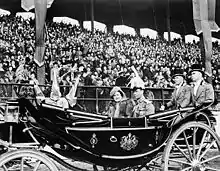Queen's Official Birthday
The Queen's Official Birthday, or the King's Official Birthday, is the selected day in some Commonwealth realms on which the birthday of the monarch is officially celebrated in those countries. It does not necessarily correspond to the date of the monarch's actual birth.
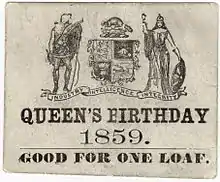
The Sovereign's birthday was first officially marked in the Kingdom of Great Britain in 1748, for King George II. Since then, the date of the king or queen's birthday has been determined throughout the British Empire, and later the Commonwealth of Nations, either by Royal Proclamations issued by the sovereign or viceroy, or by statute laws passed by the local parliament. The date of the celebration today varies as adopted by each country and is generally set around the end of May or start of June, to coincide with a higher probability of fine weather in the Northern Hemisphere for outdoor ceremonies. In some cases, it is an official public holiday, sometimes aligning with the celebration of other events. Most Commonwealth realms release a Queen's Birthday Honours list at this time.
Australia
Australian states and territories observe the Queen's Birthday on the second Monday in June, except in Western Australia and Queensland. As Western Australia celebrates Western Australia Day (formerly known as Foundation Day) on the first Monday in June, the Governor of Western Australia each year proclaims the day on which the state will observe the Queen's Birthday, based on school terms and the Perth Royal Show.[1] There is no firm rule to determine this date, though it is usually the last Monday of September or the first Monday of October. Some regional areas of Western Australia celebrate the Queen's Birthday public holiday on alternative days for locally significant dates or events.[2] In 2012, Queensland celebrated the holiday in October, as the June holiday was reserved to mark Elizabeth II's Diamond Jubilee as Queen of Australia, after which the holiday then for three years reverted to its traditional date in line with the other eastern Australian states.[3] However, starting in 2016, Queensland celebrates the holiday on the first Monday of October.[4][5]

Norfolk Island celebrates Bounty Day on 8 June, so Queen's Birthday is held on the Monday after the second Saturday in June.[6] Christmas Island has other holidays and does not hold a Queen's Birthday holiday at all.[7]
The day has been celebrated since 1788, when Governor Arthur Phillip declared a holiday to mark the birthday of the King of Great Britain. Until 1936, it was held on the actual birthday of the monarch, but, after King George V died, it was decided to keep the date on the second Monday in June.[8] This has more evenly spaced out public holidays throughout the year. While George V's successor, Edward VIII, also celebrated his birthday in June, the two sovereigns since have not: George VI's birthday was in December, very close to public holidays for Christmas, Boxing Day, and New Years, while Elizabeth II's birthday falls shortly after holidays for Good Friday and Easter and very close to ANZAC Day.
The Queen's Birthday weekend and Empire Day (24 May) were the traditional times for public fireworks displays in Australia. The sale of fireworks to the public was banned in various states through the 1980s and by the Australian Capital Territory on 24 August 2009. Tasmania is the only state and the Northern Territory the only territory to allow the sale of fireworks to the public.[9] The Queen's Birthday Honours List, in which new members of the Order of Australia and other Australian honours are named, is released on the date of the Queen's Birthday in most states.
Canada
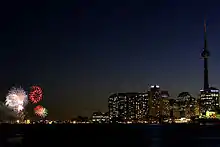
A Royal Proclamation issued on 5 February 1957 established the Canadian monarch's official birthday as the last Monday before 25 May.[10] The Sovereign's birthday had been observed in Canada since 1845, when the Legislative Assembly of the Province of Canada passed a statute to authorize the recognition of Queen Victoria's birthday, 24 May, as a public holiday.[11][12] Over the ensuing decades after Queen Victoria died in 1901 (and 24 May became Victoria Day, until 1952, when the Monday before 25 May became known by law as Victoria Day[12]), the official date in Canada of the reigning monarch's birthday changed through various Royal Proclamations: for Edward VII it continued by yearly proclamation to be observed on 24 May, but was 3 June for George V and 23 June for Edward VIII (their actual birthdays).
Edward VIII abdicated on 11 December 1936, three days before the birthday of his brother and successor, George VI. The new King expressed to his ministers his wish that his birthday not be publicly celebrated, in light of the recent circumstances. But, the Prime Minister at the time, William Lyon Mackenzie King, the rest of Cabinet, and Lord Tweedsmuir, the Governor General, felt otherwise, seeing such a celebration as a way to begin the reign on a positive note.[13] George VI's official birthday in Canada was thereafter marked on various days between 20 May and 14 June.
The first official birthday of Elizabeth II, daughter of George VI, was the last to be celebrated in June; the haphazard format was abandoned in 1952, when the Governor General-in-Council moved Empire Day and an amendment to the law moved Victoria Day both to the Monday before 25 May,[12][14] and the monarch's official birthday in Canada was by regular viceregal proclamations made to fall on this same date every year between 1953 and 1957, when the link was made permanent.[12][15] The two holidays are in law entirely distinct except for being appointed to be observed on the same day; it is a general holiday in Nunavut[16] and New Brunswick (there prescribed as a day of rest on which retail businesses must be closed[17][18]). The Queen's official birthday is marked by the firing of an artillery salute in the national and provincial capitals and the flying of the Royal Union Flag on buildings belonging to the federal Crown, if there is a second flag pole available.
The Canadian monarch has been in Canada for his or her official birthday twice. The first time was 20 May 1939, when King George VI was on a coast-to-coast tour of Canada and his official birthday was celebrated with a Trooping the Colour ceremony on Parliament Hill.[19][20] The second time was when Queen Elizabeth II was in Canada from 17 – 25 May 2005, to mark the centennial of the entries of Saskatchewan and Alberta into Confederation; no government-initiated events, aside from those dictated by normal protocol, were organized to acknowledge the official birthday. Prince Charles, heir apparent to the throne, and his wife, Camilla, in 2012 attended events in Saint John, New Brunswick, and Toronto, Ontario, marking the Queen's official birthday.[21] In 2014, the couple attended a ceremony in Charlottetown, Prince Edward Island.[22]
New Zealand
In New Zealand, Queen's Birthday is a public holiday observed on the first Monday in June. Celebrations are mainly official, including the Queen's Birthday Honours list and military ceremonies.[23] There have been proposals, with some political support,[24][25][26] to replace the holiday with Matariki (Māori New Year) as an official holiday. The idea of renaming the Queen's Birthday weekend to Hillary weekend, after mountaineer Sir Edmund Hillary, was raised in 2009.[27]
United Kingdom
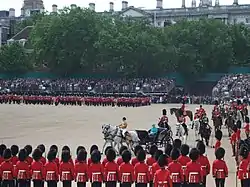
The monarch's birthday has been celebrated in the United Kingdom since 1748, during the reign of King George II. Queen Elizabeth II's Official Birthday was originally celebrated on the second Thursday of June, the same day that her father, King George VI, celebrated his Official Birthday during his reign. However, this was changed in 1959, seven years after she became Queen, and her Official Birthday has since then been celebrated on the second Saturday of June.[28] Edward VII, who reigned from 1901 to 1910 and whose birthday was on 9 November, after 1908 moved the ceremony to summer in the hope of good weather.[29][30]
The day is marked in London by the ceremony of Trooping the Colour, which is also known as the Queen's Birthday Parade. The list of Birthday Honours is also announced at the time of the Official Birthday celebrations. In British diplomatic missions, the day is treated as the National Day of the United Kingdom. Although it is not celebrated as a specific public holiday in the UK, some civil servants are given a "privilege day" at this time of year, which is often merged with the Spring Bank Holiday (last Monday in May) to create a long weekend, which was partly created to celebrate the monarch's birthday.
Parts of Scotland also mark Queen Victoria's birthday on the last Monday before or on 24 May. Local government and higher education institutions typically close on this day.
British Overseas Territories
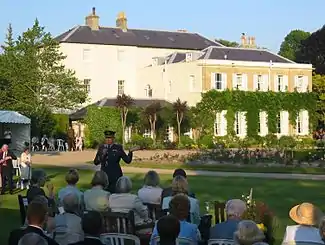
The Queen's official birthday is a public holiday in Gibraltar and most other British overseas territories. In 2008, the government of Bermuda decided the day would be, beginning the following year, replaced by National Heroes' Day,[31] despite protests from people on the island, who signed a petition calling for retention of The Queen's Official Birthday.[32] The Falkland Islands celebrate the actual day of the Queen's birth, 21 April, as June occurs in late autumn or winter there. It is a public holiday in Saint Helena, Ascension, and Tristan da Cunha, where it falls on the third Monday in April.
Other Commonwealth countries
Tuvalu celebrates the Queen's Official Birthday on the second Saturday of June.[33] In Saint Kitts and Nevis, the date of the holiday is set each year.[34] Cook Islands, Papua New Guinea, and the Solomon Islands does so on the second Monday of June. Cook Islands, a self-governing country in free association with New Zealand, also celebrates the holiday on the second Monday of June.
Despite Fiji abolishing the monarchy in 1987, following a second military coup d'état, the Queen's Birthday continued to be celebrated each 12 June until 2012. That year, the military government of Commodore Frank Bainimarama announced the holiday would be abolished.[35]
As a legacy of British rule, Malaysia continues to celebrate its monarch's official birthday during the first week of June, although it has its own elected King.
See also
- Day of the Sun (North Korea)
- Grand Duke's Official Birthday (Luxembourg)
- King's Feast (Belgium)
- Koningsdag (Netherlands)
- The Emperor's Birthday (Japan)
References
- "Department of Consumer and Employment Protection, Labour Relations division". Docep.wa.gov.au. 17 August 2012. Retrieved 5 April 2013.
- "Regional dates for the Queen's Birthday public holiday". Department of Mines, Industry Regulation and Safety. Retrieved 12 March 2019.
- "Holiday double treat for Queen's big year". Brisbane Times. Australian Associated Press. 6 November 2011. Retrieved 31 December 2011.
- "Public holidays". Queensland Government. 7 April 2016. Retrieved 2 May 2016.
- "Queensland Labour Day moved to May, Queen's Birthday to October". Brisbane Times. Australian Associated Press. 13 October 2015. Retrieved 2 May 2016.
- Queen's Birthday Holidays
- 2020 Public Holidays, Christmas Island
- "Advertising". The Queanbeyan Age. NSW: National Library of Australia. 6 June 1913. p. 5. Retrieved 1 June 2013.
- "Cracker down: ACT bans fireworks". Australian Broadcasting Corporation. 24 August 2009. Retrieved 24 August 2009.
- Elizabeth II (5 February 1957), Parliament of Canada (ed.), "A Proclamation" (PDF), Canada Gazette, Ottawa: Queen's Printer for Canada, retrieved 7 May 2015
- An Act to provide for the Management of the Customs and of matters relative to the Collection of the Provincial Revenue, S.Prov.C. 1845, c. 4, s. 9
- Department of Canadian Heritage. "Ceremonial and Canadian Symbols Promotion > Victoria Day > Sovereign's Birthday". Queen's Printer for Canada. Archived from the original on 5 February 2009. Retrieved 12 May 2009.
- Library and Archives Canada (2007), The Diaries of William Lyon Mackenzie King, Queen's Printer for Canada, p. 573, archived from the original on 16 April 2012, retrieved 14 August 2012
- Elizabeth II (12 December 1988), Holidays Act, 4: Queen's Printer for CanadaCS1 maint: location (link)
- Elizabeth II (11 October 1957), Proclaimed for Celebration of Queen's Birthday (PDF), Queen's Printer for Canada, retrieved 24 May 2011
- "Labour Standards Act, RSNWT (Nu) 1988, c L-1". Retrieved 17 May 2012.
- "Days of Rest Act: Frequently Asked Questions". Retrieved 17 May 2012.
- "Employment Standards Be Informed: Paid Public Holidays and Vacation/Vacation Pay" (PDF). Archived from the original (PDF) on 2 March 2012. Retrieved 17 May 2012.
- Bousfield, Arthur; Toffoli, Gary (1989). Royal Spring: The Royal Tour of 1939 and the Queen Mother in Canada. Toronto: Dundurn Press. p. 30. ISBN 1-55002-065-X.
- Department of Canadian Heritage. "Ceremonial and Canadian Symbols Promotion> Victoria Day> Observance in Canada of the Sovereign's Birthday". Queen's Printer for Canada. Archived from the original on 5 February 2009. Retrieved 12 May 2009.
- Department of Canadian Heritage. "Topics > Monarchy in Canada > 2012 Royal Tour > 2012 Royal Tour Itinerary". Queen's Printer for Canada. Retrieved 11 May 2012.
- Janus, Andrea (20 May 2014). "Being a grandfather puts world's challenges 'in sharper focus': Prince Charles". CTV. Retrieved 20 May 2014.
- Rudman, Brian (7 June 2010). "Clear signal from Her at the Palace". The New Zealand Herald.
- "Mayor Joins Call For Matariki Public Holiday". Scoop.co.nz. 22 June 2009.
- "No Celebrations For Queen's Birthday". Scoop.co.nz. 29 May 2009.
- Devlin, Collette (7 June 2018). "Wellington Mayor and MP support Matariki replacing Queen's Birthday holiday". Stuff.co.nz. Retrieved 1 June 2020.
- "Call to rename Queen's birthday to Hillary weekend?". TVNZ. 31 May 2009. Archived from the original on 15 June 2011.
- "The Queen's Birthday". Retrieved 11 June 2016.
- "The Queen's birthdays". royal.gov.uk, the Official Website of the British Monarchy. Archived from the original on 8 October 2011. Retrieved 1 July 2011.
The current Queen Elizabeth II celebrates two birthdays each year: her actual birthday on 21 April and her official birthday on a Saturday in June.
- The Times 9 November 1908 published the King's Birthday Honours list, apparently the first occasion of such awards. The lists were subsequently published on the monarch's official birthday in June
- "National Heroes' holiday is in June". The Royal Gazette. 9 October 2009. Retrieved 24 October 2015.
- "Bermuda ditches Queen's Birthday public holiday". Stuff.co.nz. Reuters. 17 April 2008. Retrieved 4 November 2011.
- "TuvaluIslands.com Index". BRC Online. Retrieved 24 October 2015.
- "Culture". St Kitts & Nevis. Retrieved 24 October 2015.
- "Fiji Scraps Queen's birthday holiday". NewstalkZB. 31 July 2012.
External links
- BBC News article of 2001 about the date of the Queen's Official Birthday in the UK
- The Queen's Birthday at the Royal Family website
